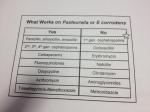This is a summary of the presentation one of the pharmacists at the hospital shared with me:
Antibiotic resistance is increasing, so we have the same bugs but new drugs. Do all infections need antibiotics?
presentation by Fredrick M. Abrahamian. Associate Professor of Medicine, UCLA School of Medicine
Antibiotics are not indicated for simple, first time, uncomplicated cases. Indications:
1. Surrounding cellulits
2. Signs of systemic toxicity
3. Immunocompromised host
4. High-risk locations (hands, face)
5. recurrent abscesses or lack of response to I&D
6. Multiple or large abscess ( greater or equal to 5 cm)
In vitro CA-MRSA is susceptible to TMP/SMX, Rifampin, Vancomycin and Linezolid
variable to Clindamycin 300-600 mg PO TID or QID (94%): Covers staphylococci, streptococci, anaerobes. Inducible resistance ( D-zone disk-diffusion test)
doxycycline (100%) 100 mg PO BID excellent tissue penetration, levofloxacin (45%), erythromycin (10%)
Rifampin 300 mg PO BID: Numerous drug interactions, risk-to-benefit ration does not justify routine use, best reserved for decolonization purposes
Rifampin drug interactions: decreases the effect or levels of beta-blockers, digoxin, ACE-inhibitors, diltiazem, nifedipine, corticosteroids, methadone, oral anticoagulants, phenytoin, sulfonlyureas, oral contraceptives
Linezolid inhibits toxin production. Tigecycline: First dose ( 100 mg IV then 50 MG IV q12 H) also covers gram negative and anaerobes, does not cover Pseudomonas plus minus Proteus. Complicated SSTIs, intra-abdominal infections, CAP (not for DRSP)
New FDA approved antimicrobial therapies: Telavancin (10 mg/kg day), Ceftaroline 600 mg q12hrs (given over 60 min)
Complicated infections: more likely mixed aerobic and anaerobic infections
Consider in patients with chronic infections, peri-rectal infections, wounds involving lower extremities (e.g. feet), vascular insufficiency (venous stasis ulcers), immunocompromising conditions example diabetes mellitus, bite-related wounds, post-operative wounds, infected burns

Necrotizing skin and soft tissue infections:
Antibiotics:
Vanco + Pip/tazo + Clinda
Alternative: Linezolid + Pip/taz
First generation cephalosporins are inactive against Pasteurella or Eikenella
2012 Infectious Diseases Society of America Clinical Practice Guideline for the Diagnosis and Treatment of Diabetic Foot Infections
Click to access 2012%20Diabetic%20Foot%20Infections%20Guideline.pdf
